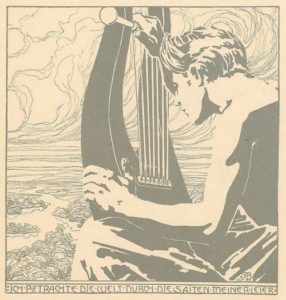 June begins with a prickly Neptune square, which establishes the tone for the month (exactitude 6/5-7). The Sun and Mercury, airy and logical in Gemini, are faced with the vast inscrutability of the oceanic mind.
June begins with a prickly Neptune square, which establishes the tone for the month (exactitude 6/5-7). The Sun and Mercury, airy and logical in Gemini, are faced with the vast inscrutability of the oceanic mind.
Popular astrology offers up plenty of symptoms associated with this notorious aspect: confusion, free-floating anxiety, forgetfulness, the tendency to space out. But this kind of delineation is descriptive rather than explicative. (1)
One way to understand this conflict is by recognizing that there’s an essential incompatibility between conscious planets (the Sun, Mercury) and transpersonal planets (Neptune, which we might call unconscious, subconscious or super-conscious, but certainly not conscious). The right and left hemispheres of the brain are at odds.
This is especially true when a rational sign like Gemini is involved.
Common Ground
The optimal response to any rendezvous between incompatible parts of the psyche is to try to put them together, instead of seeing them as battling each other.
to try to put them together, instead of seeing them as battling each other.
In this case, the mental (Sun, Mercury) and soul-driven parts of ourselves (Neptune) need to find common ground.
Creative writing, speaking or communicating, for instance, would be supported under this transit. It wouldn’t necessarily be a smooth ride; a square is not a trine, after all. But acts of creation aren’t aren’t a smooth ride, either.
Astrology doesn’t see the tension between antagonistic forces as negative, any more than artists do, who know that friction is often required to get what’s in the imagination out into the world.
Venus gets other-worldly
Venus, too, collides with the transpersonal this month. Around June 6th, she  opposes Pluto, and on the 14th-15th she squares Uranus and forms a sesquiquadrate with Neptune.
opposes Pluto, and on the 14th-15th she squares Uranus and forms a sesquiquadrate with Neptune.
The Pluto opposition invites us to descend into something deeper than superficial attraction. Its goal is pure eros: a state of merger, wherein each participant’s individuality disappears in the blending.
The mid-month square similarly leads us to surrender the individuality; but this time by ascent, not descent. Its goal, whether we realize it or not, is to experience the alien or divine (Uranus, Neptune) through someone or something we value (Venus).
Both states may be glimpsed only fleetingly, but a mere moment is often enough for something profound to occur.
Cancer and Capricorn
During the second half of June there is a series of oppositions between Cancer and Capricorn planets: these pit the two parenting archetypes against each other: Mercury & Saturn (6/15), Mercury & Pluto (6/23) and the Sun & Saturn (6/27).
These may show up literally, as a conflict between maternal vs. paternal models; i.e. the nurturing approach confronting the disciplinarian approach. More likely, the split will manifest in less explicit ways.
The emotional and self-protective parts of us may feel hemmed in by external considerations. Limited by definition, the realities represented by Capricorn feel like an affront to the tender instincts of Cancer, especially when Saturn is involved (6/15 and 27).
We are being called upon to balance the two signs, which is easier when we realize what they have in common.
Both Cancer and Capricorn are concerned with self-protection and security. The former approaches it emotionally and the latter materially, but both would choose stability over change.
 Note:
Note:
1) Descriptive imagery is useful in that it helps us identify the phenomenon in question. A descriptive phrase gives us a feel for the transit. But it doesn’t help us understand it.
This is because astrological symbols are multi-layered. They can manifest on a myriad of different levels, from the weather or a news story to our subjective state of mind. It doesn’t do a transit justice, therefore, to reduce it to a list of adjectives: descriptions that might apply to anything from the mass mood on that day to the astrologer’s guesses about what literal events might happen.
The other great limitation of this approach is the format. When astrologers are trying to explain a transit for the general population, we don’t have the reader’s chart in front of us. So we can’t know how it’s hitting that person, specifically. We don’t know whether the planets in the sky on a particular day are triggering important themes in that individual’s life, or are just part of the background fabric of the collective moment, relatively unimportant when contrasted with longer-term transits upon that person.
A personalized transit reading, by contrast, takes into account how the celestial picture fits in with the native’s own soul trajectory. It helps put into perspective the huge amount of data available in an astrological reading – data where one  transit often seems to contradict another.
transit often seems to contradict another.
An individualized reading allows a sense of proportion that is disallowed by generic columns. When transits are drawn up for a particular chart, we know where to put the emphasis. Certain transits that may be a very big deal for one native might be dwarfed by other things for another native.
A practitioner wouldn’t devote a huge chunk of time to something like Mercury Retrograde, for instance, when reading for a client who had a life-altering transit like Pluto conjoining their Moon.

